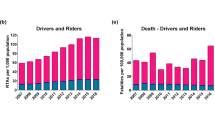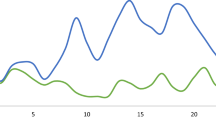Abstract
Background: Use of psychotropic drugs is known to impair driving and increase the risk of road traffic accidents. They are also the most common drugs taken in overdose in hospital-treated episodes of self-poisoning. Most patients who take psychotropic drug overdoses are discharged within 48 hours, while they still have possible subclinical drug effects.
Objective: Using a self-controlled case series design, we aimed to determine whether patients with psychotropic drug overdose are at a higher risk of a traffic accident in the period following discharge compared with a control period not associated with hospital-treated drug overdose.
Methodology: Using the New South Wales (NSW) Admitted Patient Data Collection (APDC) as the primary source, we retrieved 40 845 hospital separation records dated between 1 July 2000 and 30 June 2008 (8 years) in patients aged 18–80 years admitted to a hospital in NSW following an intentional self-poisoning with a psychotropic drug (coded X61 or X62 as the International Classification of Diseases, 10th Edition, [ICD-10] external causeof injury). Of these, 33 459 hospital separations (i.e. discharges, transfers and deaths) involving 24 284 patients were considered eligible as the patients were discharged directly into the community where they could have driven a motor vehicle. We selected three separate post-admission periods (3 days, 1 week and 4 weeks), subtracted the number of inpatient days from each and calculated three separate post-discharge periods (immediate, intermediate and extended, respectively) for each episode of overdose. The control period was the duration of the study period where the individual was aged 18 years or older, excluding the total person-days in the post-discharge period/s and the index inpatient period/s. The APDC dataset was linked to the NSW Roads and Traffic Authority CrashLink dataset to identify any accidents in which each patient was involved as a motor-vehicle driver during the follow-up period. Incidence rate ratio (IRR) for matched post-discharge and control periods was found using random effects Poisson regression.
Results: Seventy-two percent of the subjects were discharged within 2 days following their admission with overdose. Compared with the corresponding control periods the risk of a traffic accident was 3.5 times higher (IRR =3.49; 95% CI 1.66, 7.33; p = 0.001) during the immediate, 1.9 times higher (IRR= 1.88; 95% CI 1.09, 3.25; p = 0.023) during the intermediate and 1.6 times higher (IRR= 1.65; 95% CI 1.27, 2.15; p = 0.0002) during the extended post-discharge period.
Conclusions: Self-poisoning with psychotropic drugs is associated with a markedly increased risk of a traffic accident during the first few days following discharge. These findings raise clinical and medico-legal implications concerning fitness-to-drive during this period. The risk reduces with time but remains significantly elevated after 4 weeks post-overdose. Further research is necessary to find out the factors contributing to this ongoing risk.



Similar content being viewed by others
Notes
Although opioids may not be classified under psychotropic drugs in a strict sense, they are included under the term ‘psychotropic drugs’ in the present paper to avoid verbosity. However, the distinction is made when necessary.
In order to eliminate the effect of accidents that occurred during the first 3 days on the risk calculated for the 4-week post-overdose period, we also defined a post-discharge period between 3 and 28 days (i.e. a period mutually exclusive from the 3-day post-overdose period) and recalculated the IRR. Fifty-one accidents occurred during this period and the IRR remained significantly elevated (IRR 1.53, 95% CI 1.16, 2.02, p = 0.003) indicating that this is a genuine increase in accident risk, independent of the excess accidents occurred during the immediate postdischarge period.
References
Dassanayake T, Michie P, Carter G, et al. Effects of benzodiazepines, antidepressants and opioids on driving: a systematic review and meta-analysis of epidemiological and experimental evidence. Drug Saf 2011; 34(2): 125–56
Rapoport MJ, Lanctot KL, Streiner DL, et al. Ben-zodiazepine use and driving: a meta-analysis. J Clin Psychiatry 2009; 70(5): 663–73
Vermeeren A. Residual effects of hypnotics: epidemiology and clinical implications. CNS Drugs 2004; 18(5): 297–328
Barbone F, McMahon AD, Davey PG, et al. Association of road-traffic accidents with benzodiazepine use. Lancet 1998; 352(9137): 1331–6
Ray WA, Fought RL, Decker MD. Psychoactive drugs and the risk of injurious motor vehicle crashes in elderly drivers. Am J Epidemiol 1992 Oct 1; 136(7): 873–83
Neutel CI. Risk of traffic accident injury after a prescription for a benzodiazepine. Ann Epidemiol 1995 May; 5(3): 239–44
Engeland A, Skurtveit S, Morland J. Risk of road traffic accidents associated with the prescription of drugs: a registry-based cohort study. Ann Epidemiol 2007 Aug; 17(8): 597–602
Leveille SG, Buchner DM, Koepsell TD, et al. Psychoactive medications and injurious motor vehicle collisions involving older drivers. Epidemiology 1994; 5(6): 591–8
Ravera S, van Rein N, de Gier JJ, et al. Road traffic accidents and psychotropic medication use in the Netherlands: a case-control study. Br J Clin Pharmacol 2011; 72(3): 505–13
Bramness JG, Skurtveit S, Neutel CI, et al. Minor increase in risk of road traffic accidents after prescriptions of anti-depressants: a study of population registry data in Norway. J Clin Psychiatry 2008; 69(7): 1099–103
Gibson JE, Hubbard RB, Smith CJP, et al. Use of self-controlled analytical techniques to assess the association between use of prescription medications and the risk of motor vehicle crashes. Am J Epidemiol 2009; 169(6): 761–8
Bachs LC, Engeland A, Morland JG, et al. The risk of motor vehicle accidents involving drivers with prescriptions for codeine or tramadol. Clin Pharmacol Ther 2009; 85(6): 596–9
Coben JH, Davis SM, Furbee PM, et al. Hospitalizations for poisoning by prescription opioids, sedatives, and tranquilizers. Am J Prev Med 2010; 38(5): 517–24
National Institute of Health. Hospital episode statistics: primary diagnosis: 3 character 2009–10 [online]. Available from URL: http://www.hesonline.nhs.uk/Ease/servlet/ContentServer?siteID=1937&categoryID=203 [Accessed 2011 Aug 29]
Australian Institute of Health and Welfare National Hospital Morbidity Database. Separation, patient day and average length of stay statistics by principal diagnosis in ICD-10-AM, Australia, 1998–99 to 2007–08 [online]. Available from URL: http://www.aihw.gov.au/hospitals-data-cube/?id=6442475319 [Accessed: 2011 Jun 9]
Whitaker HJ, Farrington CP, Spiessens B, et al. Tutorial in biostatistics: the self-controlled case series method. Stat Med 2006; 25(10): 1768–97
Farrington CP. Relative incidence estimation from case series for vaccine safety evaluation. Biometrics 1995; 51(1): 228–35
Hochberg Y. A sharper Bonferroni procedure for multiple tests of significance. Biometrika 1988 Dec 1; 75(4): 800–2
National Institute of Health. Hospital episode statistics: inpatient data by external cause 2009–10 [online]. Available fom URL: http://www.hesonline.nhs.uk/Ease/servlet/ContentServer?siteID=1937&categoryID=211 [Accessed 2011 Dec 12]
Australian Bureau of Statistics. Population estimates by age and sex, New South Wales by geographical classification [ASGC 2010], 2005 and 2010 [online]. Available from URL: http://www.abs.gov.au/AUSSTATS/abs@.nsf/DetailsPage/3235.02010?OpenDocument [Accessed 2011 Aug 30]
NSW Roads and Traffic Authority. Road traffic crashes in New South Wales: statistical statement: year ended 31 December 2005 [online]. Available from URL: http://www.rta.nsw.gov.au/roadsafety/downloads/accidentstats2005.pdf [Accessed 2011 Aug 30]
McLean AJ, Holubowycz OT, Sandow BL. Alcohol and crashes: identification of relevant factors in this association: Road Accident Research Unit: University of Adelaide; 1980 [online]. Available from URL: http://www.infrastructure.gov.au/roads/safety/publications/1980/Alcohol_1.aspx [Accessed 2011 Mar 12]
Compton RP, Blomberg RD, Moskowitz H, et al. Crash risk of alcohol-impaired driving. In: Mayhew DR, Dussault C, editors. Proceedings of the 16th International Conference on Alcohol, Drugs and Traffic Safety; 2002 Aug 4–9; Montreal
Borkenstein RF, Crowther RF, Shumate RP, et al. The role of the drinking driver in traffic accidents. Bloomington (IN): Department of Police Administration, Indiana University, 1964
Acknowledgements
This study was funded by the University of Newcastle Centre for Health Record Linkage (CHeReL) Committee with CheReL Data Linkage Credits. All stages of the study and manuscript preparation were independent of the funding body. We acknowledge NSW Department of Health for providing hospital separation data, NSW Roads and Traffic Authority (RTA) for providing traffic accident data and CHeReL for conducting primary APDC and CrashLink data linkage. We thank Jane Roberson and Catherine D’Este from the School of Medicine and Public Health of the University of Newcastle for their contribution in designing this study. The authors have no conflicts of interest to declare.
Author information
Authors and Affiliations
Corresponding author
Rights and permissions
About this article
Cite this article
Dassanayake, T.L., Jones, A.L., Michie, P.T. et al. Risk of Road Traffic Accidents in Patients Discharged Following Treatment for Psychotropic Drug Overdose. CNS Drugs 26, 269–276 (2012). https://doi.org/10.2165/11599790-000000000-00000
Published:
Issue Date:
DOI: https://doi.org/10.2165/11599790-000000000-00000




